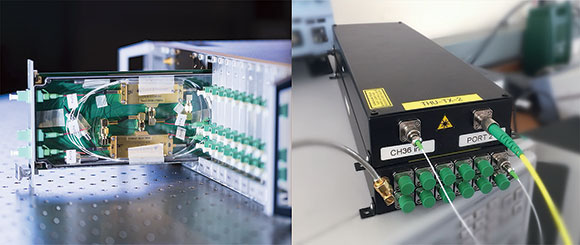
One of the most critical and challenging design aspects of the Square Kilometre Array (SKA) radio telescope project, namely time synchronisation, came a step closer to resolution recently when the board of the SKA’s international Signal and Data Transport (SaDT) consortium selected the synchronisation distribution system designs to be used for both SKA telescopes, endorsing the decision of a panel of leading experts in the field of time synchronisation.
While optical fibres are incredibly stable and suited to transport data, mechanical stresses and thermal changes do affect the fibre, degrading the stability of the transmitted signals over long distances. The long distances between the SKA antennas means radio waves from the sky reach each antenna at different times. With eventually thousands of antennas spread over continental scales and therefore thousands of kilometres of fibre, one of the most complex technical challenges for the SKA to function properly is to make sure the signals from the antennas are aligned with extreme precision to be successfully combined by the SKA’s supercomputers.

“Given the scale of the SKA, this is an engineering problem that hadn’t really been faced before by any astronomical observatory,” said André Van Es, the SaDT engineering project manager supervising the consortium’s work for SKA Organisation (SKAO).
To achieve this level of precision or ‘coherence’ across the array, the SKA requires a synchronisation distribution system that supresses these fibre fluctuations in real time. “The performance required is for less than 2% coherence loss. Bearing in mind a 1% loss is equivalent to losing two dishes or antenna stations, it’s crucial that we get this right for the telescopes to be effective,” explained SKAO timing domain specialist Rodrigo Olguin.

The pulses sent by the synchronisation distribution system travel to each antenna using the optical fibre network also used for transporting astronomical data to the SKA’s central computer. The system then takes into account the mechanical stresses and thermal changes in the fibre and corrects the timing difference to make sure all signals coming from the antennas are digitised synchronously.
An optical fibre-based synchronisation distribution system designed by a team from the International Centre for Radio Astronomy Research (ICRAR) in Perth was selected for the SKA-mid dishes in South Africa, and a system designed by Tsinghua University in Beijing for the SKA-low antennas in Australia. “This decision based on the SKA’s requirements combines both cost-effectiveness and reliability of the designs, resulting in an optimal two-system solution for the telescopes,” explained Van Es.

According to Dr Sascha Schediwy from ICRAR and the University of Western Australia, ICRAR’s frequency synchronisation system continuously measures changes in the fibre link and applies corrections in real-time with fluctuations of no more than five parts in one-hundred trillion over a 1-second period. To put that in perspective, he points out that a clock relying on a signal of that stability would only gain or lose a second after 600 000 years.
Dr. Bo Wang of Tsinghua University explains: “Our system employs a frequency dissemination and synchronisation method that features phase-noise compensation performed at the client site. One central transmitting module can thus be linked to multiple client sites, and future expansion to additional receiving sites can be realised without disrupting the structure of the central transmitting station.”
The very accurate timing and synchronisation systems will enable the SKA to contribute to many fields, from mapping the distribution of hydrogen in the universe over time to studying pulsars and detecting gravitational waves on a galactic scale, making it complementary to the LIGO and VIRGO gravitational wave observatories. “The technologies behind these synchronisation systems are also likely to find applications beyond astronomy. Think about currency trading, which requires extreme accuracy in transactions,” added Van Es.
For more information visit www.skatelescope.org

© Technews Publishing (Pty) Ltd | All Rights Reserved